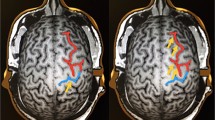Abstract
Background
Transcranial magnetic stimulation (TMS) is being used in the pre-operative diagnostics of patients with tumors in or near the motor cortex. Although the main purpose of TMS in such patients is to map the functional areas of the motor cortex in spatial relation to the tumor, TMS also provides some numerical neurophysiological measurements of the functional status of the patient’s motor system. The aim of this paper is to provide reference values for these neurophysiological measurements from a large and varied clinical sample.
Methods
TMS was used in the pre-operative work-up of patients with various types of tumors in or near the motor cortex during a 3-year period. Data was collected prospectively in 100 patients, yet this is a post hoc report.
Results
Patient characteristics had no influence on the neurophysiological parameters. The response latency time was almost never different in the tumorous versus healthy hemisphere, so clinicians should be suspicious if they find interhemispheric differences for latency. A high interhemispheric ratio of resting motor threshold (RMT) or a low interhemispheric ratio of motor evoked potential (MEP) amplitude appear to suggest immanent deterioration of the patient’s motor status.
Conclusion
In addition to topographic cortical mapping, TMS also serves as a neurophysiological assessment of the functional status of the patient’s motor system. The results presented here provide clinicians with a set of reference values to contextualize findings in their own tumor patients. Further research is still needed to better understand the full clinical relevance of these neurophysiological parameters.



Similar content being viewed by others
References
Nakamae T, Tanaka N, Nakanishi K, Fujimoto Y, Sasaki H, Kamei N, Hamasaki T, Yamada K, Yamamoto R, Izumi B, Ochi M (2010) Quantitative assessment of myelopathy patients using motor evoked potentials produced by transcranial magnetic stimulation. Eur Spine J 19:685–690
Perretti A, De Rosa A, Marcantonio L, Iodice V, Estraneo A, Manganelli F, Garavaglia B, Filla A, Santoro L, De Michele G (2011) Neurophysiological evaluation of motor corticospinal pathways by TMS in idiopathic early-onset Parkinson’s disease. Clin Neurophysiol 122:546–549
Picht T, Schmidt S, Brandt S, Frey D, Hannula H, Neuvonen T, Karhu J, Vajkoczy P, Suess O (2011) Preoperative functional mapping for rolandic brain tumor surgery: comparison of navigated transcranial magnetic stimulation to direct cortical stimulation. Neurosurgery 69:581–589
Picht T, Schulz J, Hanna M, Schmidt S, Suess O, Vajkoczy P (2012) Assessment of the influence of navigated transcranial magnetic stimulation on surgical planning for tumors in or near the motor cortex. Neurosurgery 70:1248–1257
Rossini PM, Barker AT, Berardelli A, Caramia MD, Caruso G, Cracco RQ, Dimitrijević MR, Hallett M, Katayama Y, Lücking CH (1994) Non-invasive electrical and magnetic stimulation of the brain, spinal cord, and roots: basic principles and procedures for routine clinical application: report of an IFCN Committee. Electroencepalogr Clin Neurophysiolo 91:79–92
Säisänen L, Julkunen P, Niskanen E, Danner N, Hukkanen T, Lohioja T, Nurkkala J, Mervaala E, Karhu J, Könönen M (2008) Motor potentials evoked by navigated transcranial magnetic stimulation in healthy subjects. J Clin Neurophysiol 25:367–372
Schippling S, Schneider SA, Bhatia KP, Münchau A, Rothwell JC, Tabrizi SJ, Orth M (2009) Abnormal motor cortex excitability in preclinical and very early Huntington’s disease. Biol Psychiatry 65:959–965
Wedekind C, Klug N (2000) Assessment of Facial nerve function in acoustic tumor disease by nasal muscle f waves and transcranial magnetic stimulation. Muscle Nerve 23:58–62
Wedekind C, Vahl J, Ernestus R-I, Klug N (2000) Prognostic Significance of Electrophysiologic Investigation for Facial Nerve Outcome in Acoustic Neuroma Surgery. Muscle Nerve 23:1868–1871
Acknowledgments
This research was supported in part by a grant from the Berliner Krebsgesellschaft to Thomas Picht. We would like to thank Adela Castelló, MPH, MSc, and Michael Hanna, PhD, (both from Mercury Medical Research & Writing) for providing publication consulting (MH), statistical advising & analysis (AC, MH), and medical writing services (MH).
Conflicts of interest
None.
Author information
Authors and Affiliations
Corresponding author
Additional information
Thomas Picht and Valerie Strack contributed equally to this paper.
Rights and permissions
About this article
Cite this article
Picht, T., Strack, V., Schulz, J. et al. Assessing the functional status of the motor system in brain tumor patients using transcranial magnetic stimulation. Acta Neurochir 154, 2075–2081 (2012). https://doi.org/10.1007/s00701-012-1494-y
Received:
Accepted:
Published:
Issue Date:
DOI: https://doi.org/10.1007/s00701-012-1494-y




